Imagine a ride so frightening, guests would need to sign a waiver of liability to enter the queue; so terrifyingly intense, no one under 16 or over 55 would be allowed aboard for “physical health and safety”; so dizzyingly, maddeningly extreme, guests would be limited to ride no more than once per day for their own “emotional health”; so cutting-edge, it would feature a mysterious world’s-first element that no other roller coaster on Earth had ever even attempted.
Would you be in line to tackle the world’s first “psychoaster?” If so, that would obviously make you a born-and-bred thrillseeker looking to see just how far a modern roller coaster can go. …So how might you feel if your multi-hour wait leads to a ride about as “extreme” as Big Thunder Mountain?
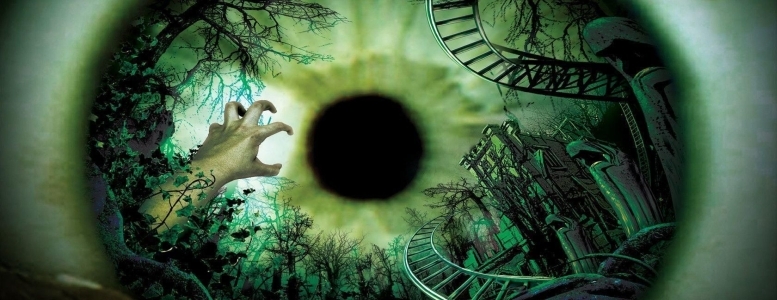
That was the shocking reality faced by guests who showed up in droves to tackle TH13TEEN, the psychological thrill ride that opened at England’s Alton Towers in 2010. The would-be record-breaker promised (and delivered) a world’s first… but as part of one of the most infamously flopped marketing campaigns in the history of the industry. Today, we’ll dig into the clever creation of Thirteen, go for a virtual ride aboard the coaster, and learn from the past to see how a botched publicity stunts forever stunted this coaster’s growth.
But as any reader of our Declassified Disasters series knows, any ride’s story – good or bad – begins before the ride is even dreamed of… (Please note, this feature will also reveal “spoiler” elements for two other attractions, Verbolten at Busch Gardens Williamsburg and Hagrid’s Magical Creatures Motorbike Adventure at Universal’s Islands of Adventure. Read at your own risk!)
And before we head off, remember that you can unlock rare concept art and audio streams in this story, access over 100 Extra Features, and recieve an annual Membership card and postcard art set in the mail by supporting this clickbait-free, in-depth, ad-free theme park storytelling site for as little as $2 / month! Become a Park Lore Member to join the story! Until then, let’s start at the beginning…
Towers through time
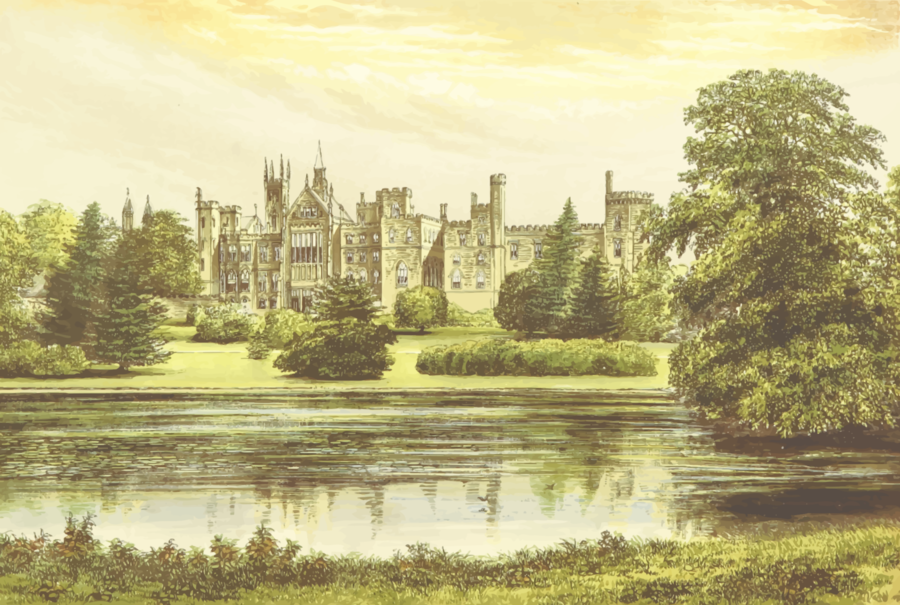
Alton Towers is a theme park as only the United Kingdom could offer.
Located in Staffordshire, England about two hours north of London, the park is steeped in history… even if it’s technically only about as old as Epcot. That’s because Alton Towers is built around the real, true remains of the eponymous Towers – the stately manor home of the 15th Earl of Shrewsbury, completed in 1814. When the Earl’s family sold the manor a century later, the home fell into disrepair. It was boarded up, its fixtures sold, and left as an empty shell.
However, through the 1960s and ‘70s, the home – and its surrounding gardens – were opened intentionally as an attraction where visitors could tour and picnic among the lavish grounds, boat across a picturesque lake, and ride across the property on either a chairlift or a 2-foot gauge miniature railway. Like turn-of-the-century “picnic parks” across America, Alton Towers had all the makings of a modern theme park… It just needed rides.
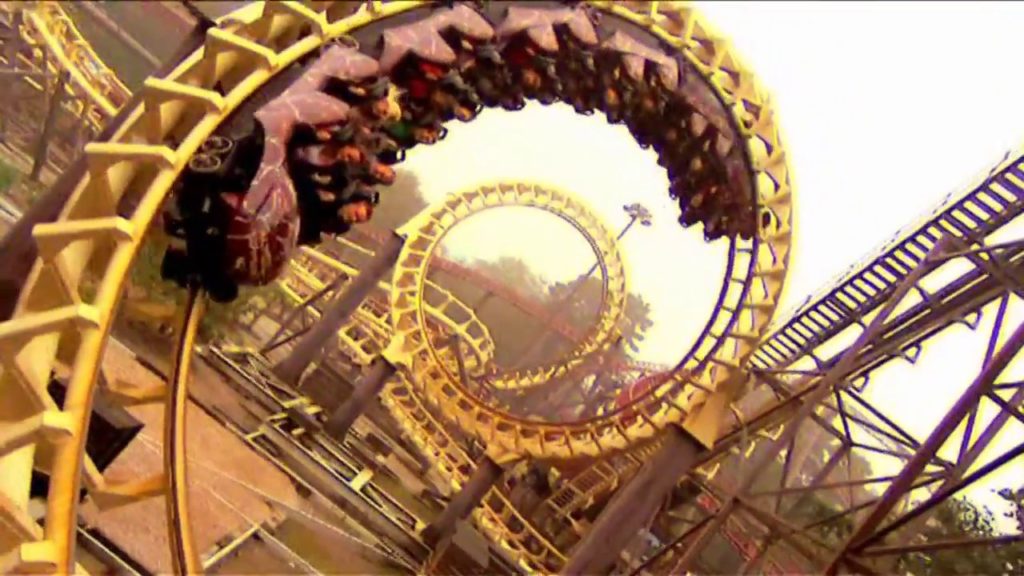
To that end, the formal opening date of Alton Towers as a theme park proper is typically considered 1980 – the year that the property welcomed the classic, double-inverting Corkscrew, a Vekoma steel roller coaster costing £1.25 million.
As tends to be the case in the slow-and-steady development of historic amusement parks, Corkscrew was just the start. The park map below represents Alton Towers two years after Corkscrew’s introduction – when the bright yellow steel coaster was still an oddity set among the elegant gardens, museums, shops, arcades, restaurants, and playgrounds of an increasingly-expanding tourist destination…
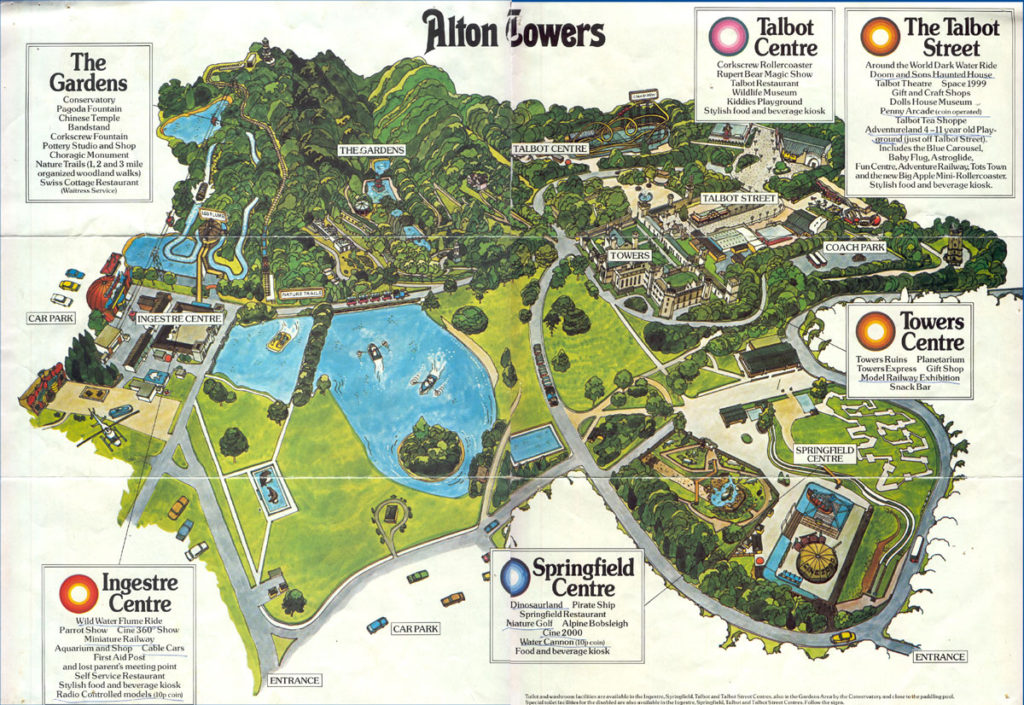
… But before long, coasters would become the norm and not the exception.
Alton Towers was purchased in 1990 by the Tussauds Group (today, Merlin Entertainments) – best known as the present owners of Madame Tussauds wax museums, Sea Life aquariums, LEGOLAND parks, the “Eye” Ferris wheels, the “Dungeons” attractions, and fellow U.K. theme parks Chessington World of Adventures and Thorpe Park. Infused with the new resources Tussauds could offer, everything at Alton Towers was soon to change…
Secret weapons
In 1994, Alton Towers found its place on the map.
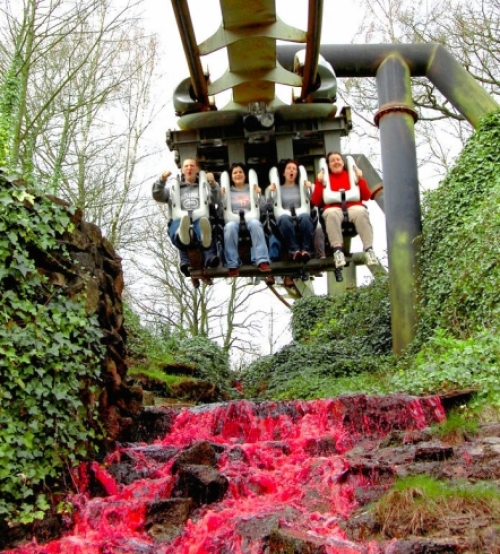
That year, the park debuted a new themed area called the Forbidden Valley, resembling a desolate, post-apocalyptic world of standing stones and the rusted, archaic remains of human civilization. Remnants of human war are scattered about, but all seem to be half-consumed by strange, fleshy, red tendrils reaching through the ground… Though oxidized, gnarled, thrilling flat rides dotted the sci-fi forest landscape, the anchor of this treacherous valley was a ride originally known only by the code name “Secret Weapon”: Nemesis.
Considered one of the best inverted roller coasters on Earth, Nemesis sends guests twisting and flipping through the air. But that’s not all. They say necessity is the mother of invention. That’s never been more true than for the coaster designers adding to Alton Towers…
Due to a uniquely restrictive height requirement (wherein Alton Towers’ coasters must be concealed beneath the natural treeline), Nemesis was constructed in trenches and valleys, tearing over blood-red rivers and twisting through the horrific, interdimensional, insectoid exoskeleton of an ancient alien whose body serves as its loading station – and the origin of those tendrils consuming the land. Today, the ride’s terrain-hugging, subterranean layout is regarded as one of the world’s best.
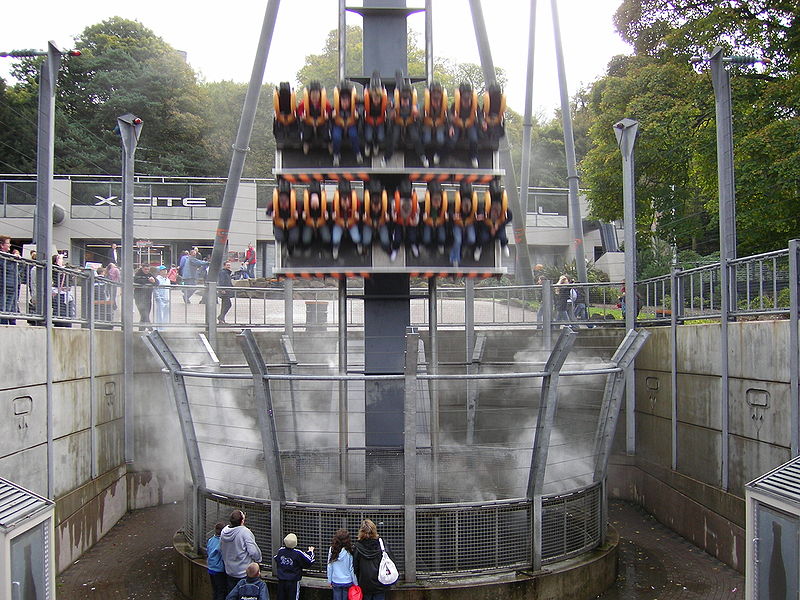
In 1998, the park’s next “Secret Weapon” debuted in another reimagined land. In X-Sector – themed to a mysterious and sinister government facility testing the limits of human endurance – opened Oblivion, the first of coaster manufacturer B&M’s now-famous Dive Machines. Seated eight-across, riders were perched over the edge of a vertical drop before plummeting into a smoke-filled black hole in the ground.
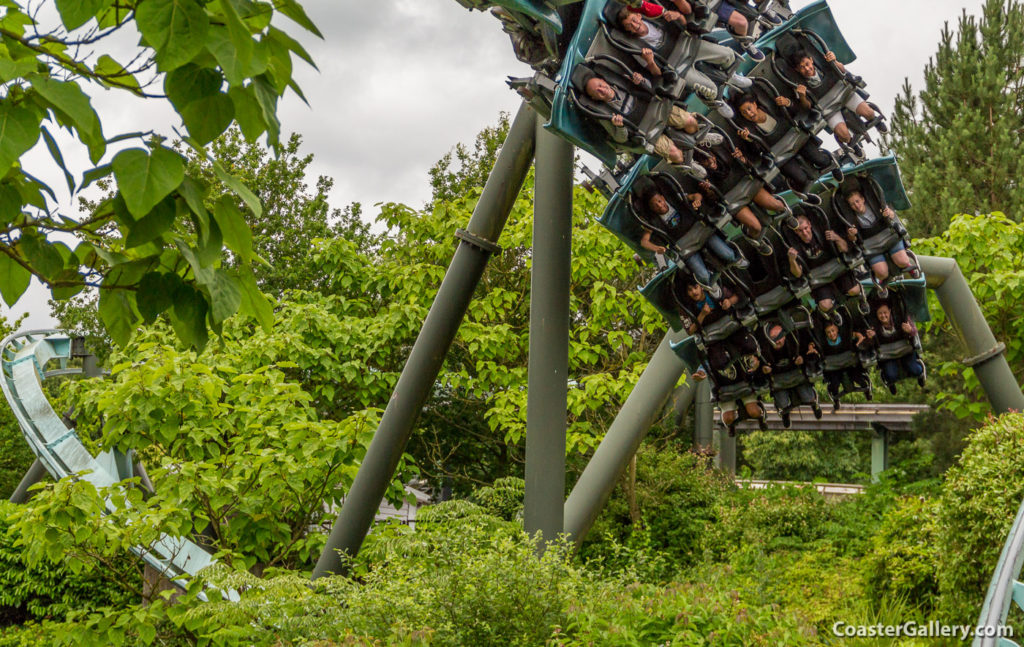
Then came the next “Secret Weapon,” Air. B&M’s first-ever flying coaster, this graceful ride was constructed in a new, futuristic, green, oasis-like sub-section within the Forbidden Valley, as if nature were reclaiming the vast desolation of the land’s post-apocolypse setting. Twisting and diving through the landscape, Air set the intense yet poetic tone for other flying coasters, like SeaWorld’s Manta.
And like all coasters at Alton Towers, it laid low, diving and twisting through the treeline, differentiating it from the swooping, soaring, giant inversions of flying coasters to come.
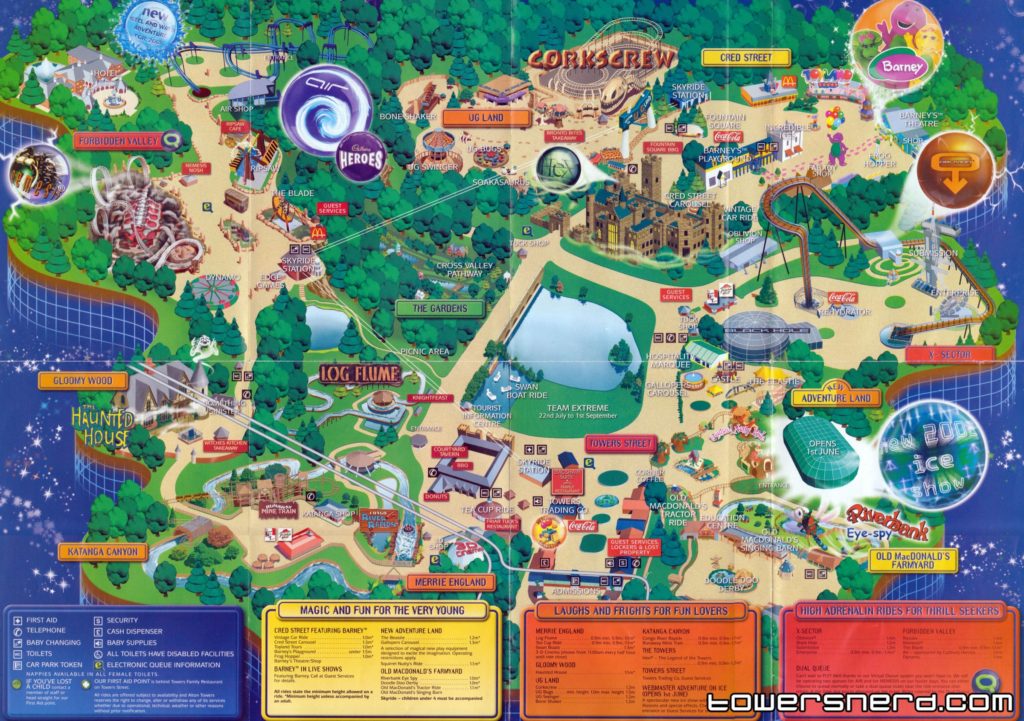
That’s what we mean when we say that in just two decades, Alton Towers had gone from a leisure gardens with Corkscrew alone into a park packed with “Secret Weapons” and prototype coasters, often wrapped in elaborate environments, well-decorated “lands,” and dark mythologies… It’s that mix of thrill and theme that makes the park a destination for Disneyland’s fans as much as Cedar Point’s.
More to the point, many of Alton Towers’ most beloved coasters have found a pretty perfect balance between environment, atmosphere, and adrenaline; coasters that are more than coasters, enhanced by their stories and surroundings. But not every project at the park has found that balance… and on the path to Thirteen, we’ll pass some prime examples.
Dinosaurs, dragsters, and… demons?
By the late 1990s, Alton Towers had used its “Secret Weapons” to become one of the most notable thrill parks on the globe. Meanwhile, the coaster that started it all – 1980’s Corkscrew – looked like a charmingly naive throwback… downright prehistoric compared to the park’s new-age, technological thrills. Given its status as the park’s “crudest” coaster, an all-too-appropriate overlay soon came to Corkscrew.
In 1999, the midway around Corkscrew was redressed as “Ug Land,” a new, comical, Stone Age circus grafted with prehistoric props befitting a fairgrounds from The Flintstones. Caveman-themed family flat rides, mastadon tusks, midway games, and rockwork were scattered through the area.
Corkscrew itself was accentuated with dinosaur bones, a ribcage tunnel, and a T. rex skull along its course (seen in a Member-exclusive rare concept art above) – the ride’s definitive form for a generation. As a family area offering a classic coaster practically custom-made to be the first “big” ride for up-and-coming thrillseekers, Ug Land was a good fit for the park, and a fine example of environment, atmosphere, and adrenaline in balance.
Then things in Ug Land got weird.
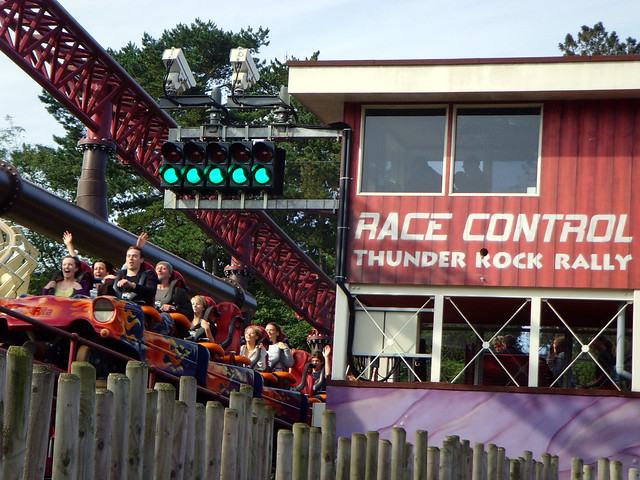
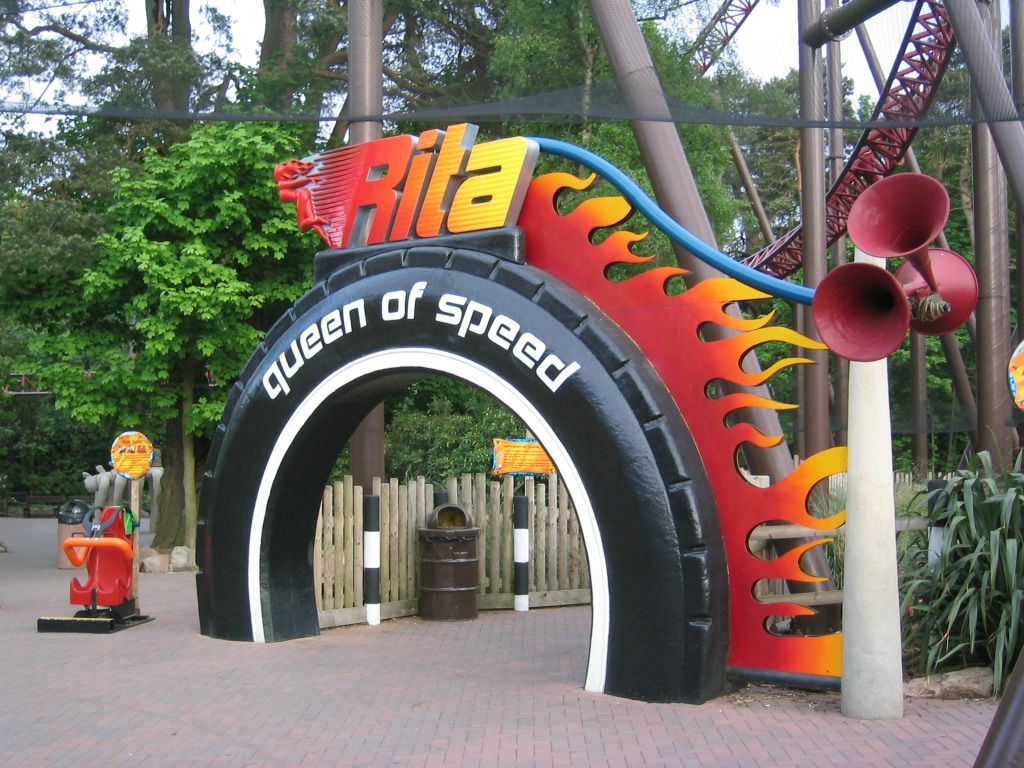
In 2005, Corkscrew was joined by a headlining neighbor, Rita – Queen of Speed. Coming just a year after the opening of Cedar Point’s world-famous Top Thrill Dragster (and built by the same manufacturer), Rita operated off the same mechanics and theme (even if it was an eighth the size of the 420-foot tall landmark, thanks again to Alton Towers’ treeline regulation).
Though its cherry red track, corrugated steel station, and hot rod race aesthetic was accentuated with occasional animal print, rock, wood fencing, and allusions to a Stone Age-stylized “Thunder Rock Rally,” it would be a stretch to imagine Rita – with its burning rubber tire entry portal – as anything but an outlier in Ug Land. So even if it wouldn’t be fruitful to hold Alton Towers to Disney or Universal standards, it’s easy to see that Rita offset the environment-atmosphere-adrenaline balance of Ug Land.
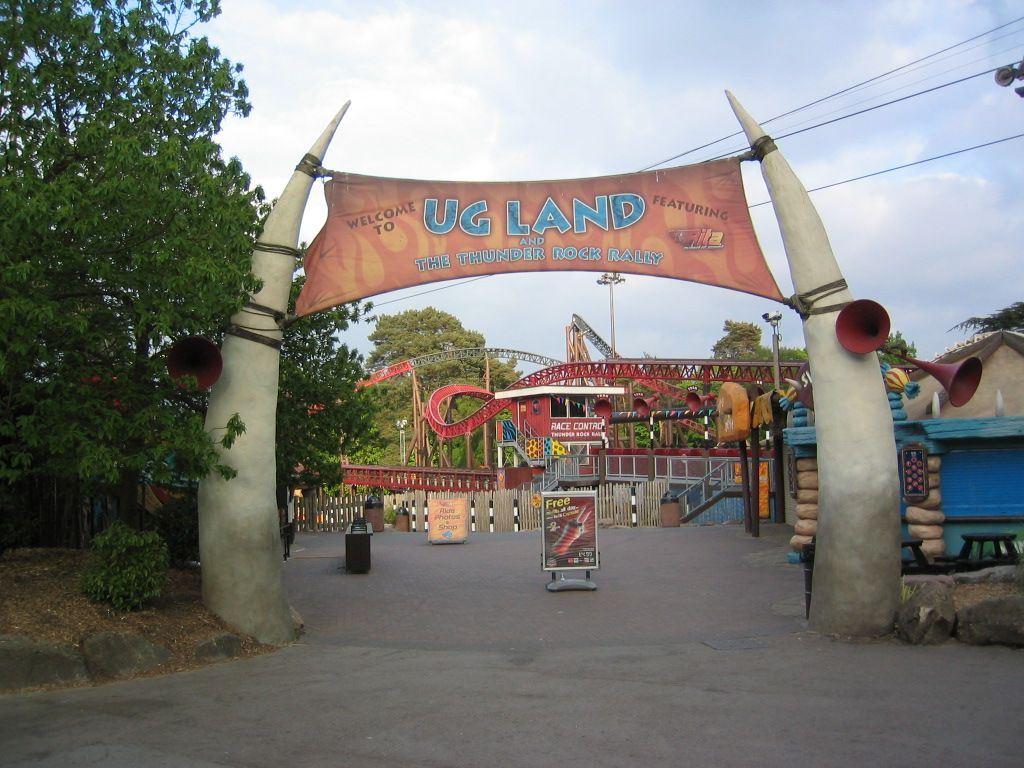
Corkscrew and Rita coexisted in Alton Towers’ Ug Land for just three years. In 2008, the park announced that Corkscrew would finally go extinct. The ride that started Alton Towers on its modern theme park path would be closed on November 9, 2008, ending a 28 year lifetime. (Its double-corkscrews were salvaged and relocated to the front of the park, where they act as a centerpiece over the entrance plaza.)
Stranger still, Ug Land outlived Corkscrew’s removal, leaving the park’s caveman-themed corner with only the modern, hot-rod racing Rita as its anchor.
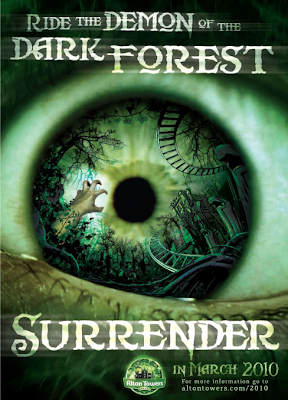
But behind the scenes, Merlin’s in-house “Making Magic” team was laying the groundwork for a replacement not just for Corkscrew, but for the entire dinosaur-themed carnival anchored by a dragster-themed coaster. “Secret Weapon 6” was officially on the way, with a “world’s first” element no one had ever seen before. In October 2009, posters on the construction wall around Corkscrew’s empty plot gave just one hint toward the ride that would take Corkscrew’s place in spring 2010:
“Ride the Demon of the Dark Forest.“
And that’s where the problems begin… Read on…



